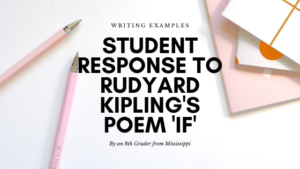Introduction:
In last week’s blog, we wrote about how to utilize the free resource, Padlet, in your classroom. This past week, I used it in my classroom as a way to review parts of an essay. After instruction, students wrote their versions of introductions, body paragraphs, and conclusions. Once they completed each part of the essay, they reviewed other classmates’ submissions on Padlet and “liked” the posts that best accomplished the purpose of that part of the essay. Below I have posted my second and third-block eighth grader’s “Charles” final essays.
Writing Task:
You have read Shirley Jackson’s short story “Charles” about a young boy entering school for the first time. Write an essay describing a characteristic of the boy and how it is developed in the story. Be sure to use specific evidence to support your response.
Second Block’s “Charles” Essay:
“Charles was bad again.” This line is from the short story “Charles” written by Shirley Jackson where she tells a story about a clever kindergarten boy named Laurie. The little boy came home every day telling a story about a kid named Charles who was bad at school, but in the end, the kid who was bad at school was actually Laurie. The boy is clever because he tricked his parents for weeks thinking a kid named Charles was bad, but really it was him.
Throughout the entire story, the author effectively demonstrates Laurie’s cleverness through his actions and words. After Laurie arrives home late on Monday, bursting with stories about Charles’s troublesome behavior, he eagerly shares in paragraph 28, “Charles yelled so in school they sent a boy in from first grade to tell the teacher she had to make Charles keep quiet, and so Charles had to stay after school. And so all the children stayed to watch him.” In a display of his quick thinking, Laurie comes up with a swift excuse to fool his parents, revealing his ability to think on his feet. By vividly describing the situation, Laurie makes it appear as though his made-up persona, Charles, is a real troublemaker, when in reality, it’s Laurie enduring the punishment. This moment highlights Laurie’s knack for creating a believable story in the moment, showcasing his cleverness and rapid problem-solving skills.
Later in the story, Laurie’s cleverness is spotlighted when his invention of a fictional character named Charles is revealed. The author uses a conversation between Laurie’s mother and teacher to make the final revelation as Laurie’s teacher remarks, “The first week or so was a bit challenging, she said in a composed manner. But now he’s turned into a great little helper, with occasional slip-ups, naturally.” This indicates that Laurie is the one causing disruptions. During his initial week of kindergarten, Laurie pins the blame on a troublemaker named Charles; however, his strategy shifts, and he starts claiming to be the teacher’s assistant who only occasionally gets into trouble. Interestingly, this mirrors what the teacher had told Laurie’s mother, but now it’s Laurie instead of Charles at the center of the mischief.
When one considers Laurie’s actions and words as well as the conversation between Laurie’s mother and teacher, it is easy to see just how clever Laurie is. He uses his cleverness by making up a kid named Charles and tricking everyone into thinking that a boy is causing chaos at school. However, it was Laurie the whole time causing all the chaos and trouble. He just wanted a disguise so he didn’t get in trouble with his parents. If he was able to use that kind of cleverness like that, just imagine all the other things he could do.
Third Block’s “Charles” Essay:
Have you ever tried to be a little mischievous like an MLB pitcher using pine tar or Tom Brady with a deflated football? In the short story “Charles” by Shirley Jackson, the main character Laurie is exactly that – mischievous. Laurie the whole time was tricking his parents by doing bad things while he was at school and saying it was a boy named Charles. His mother goes to a PTA meeting and figures out there is no boy named Charles and Laurie has been doing the bad stuff the whole time. All through the short story, Laurie shows many ways of how he is being mischievous.
As the story begins, the author portrays Laurie to be a mischievous kid. Laurie makes up a character to blame all of his troublesome behaviors on. In the passage, Laurie tells his parents that the teacher spanks a kid at school, “for being fresh.” Laurie is being very mischievous for blaming it on a character he made up. Laurie doesn’t want to get in trouble with his parents for misbehaving at school, so he blames everything on this so-called “Charles” kid who Laurie’s parents believe is a real person. This kind of behavior is a result of Laurie being mischievous.
Laurie shows he is mischievous by tricking his parents when he is late and says that it was actually someone named Charles’s fault. In paragraph 27 Laurie states, “‘Charles had to stay after school today…Everyone stayed with him.’” This shows the mother repeating what Laurie had told her earlier about Charles, and she suspected nothing of Laurie being the real one in trouble. Also, in the final two paragraphs of the story, Laurie’s teacher and mother say, “‘Yes…you must have your hands full in that kindergarten, with Charles.’ ‘Charles?’ she said. ‘We don’t have any Charles in the kindergarten.’” This proves Laurie being very mischievous and not only tricking his parents into believing him but also tricking his teacher into thinking he was telling his parents everything that happened at school.
When one considers Laurie’s words and actions throughout the story, his mischievous behavior is clear. Laurie tricked his parents into thinking a kid named Charles was misbehaving while it was actually him. He was good sometimes but only to get more attention. But, besides that, he was mischievous the entire time. After the PTA Meeting, even Laurie’s character shows that you won’t always get away with things.
Support
If you’d like to see more classroom activities when they’re published, follow our Facebook Page. We post content here each week for teachers and students. Thank you for your support. Every page viewed, comment, social media like and share is greatly appreciated.



